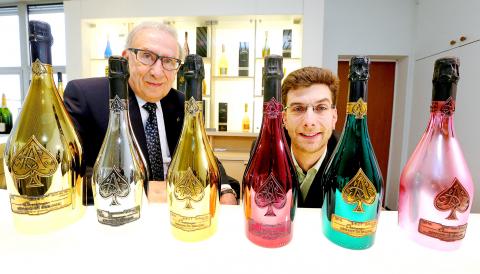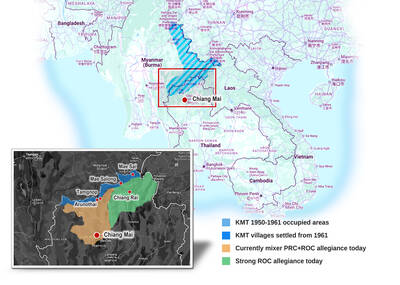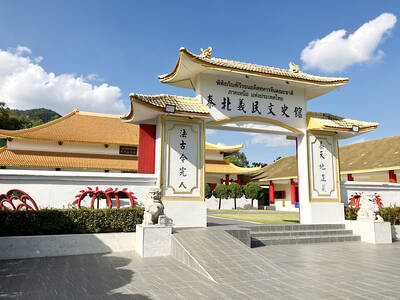Lose the Cristal. Pop the “Ace of Spades” Armand de Brignac — but have a well-stuffed wallet ready.
Since the champagne’s cameo role in a video featuring rapper Jay Z, Armand de Brignac has climbed from its luxurious, but obscure niche to become the bubbly of choice for today’s star-studded, bling-conscious crowd.
So fond of the fizz is Jay Z, that he bought the brand with the ace of spades logo last month. A bottle sells for around US$370 in its principal north American and European markets. Outsize “Midas” bottles, which at 30 liters are said to be the largest champagne bottles in the world, have sold for nearly US$236,000.

Photo: AFP / FRANCOIS NASCIMBENI
The gradual escalation of price has coincided with its embrace by some of the planet’s most conspicuous celebrity consumers.
The unabashedly flashy brand has become a favorite at soirees featuring the rich and famous, like David Beckham, Leonardo di Caprio and Olympic hero Usain Bolt. The brand’s bling quotient, it turns out, has been an essential part of its identity since its conception.
“It all began as a kind of joke in early 2000,” says Jacques Cattier, 70, who presides over the family champagne business from the 33-hectare farm that his ancestors founded in 1763. “We wanted to make an entirely superlative champagne — the most beautiful, the most expensive and the best.”
The result was a glittery, metallic bottle emblazoned with the ace of spades logo.
Cattier took his fashion statement beverage to market in 2006 with a 20,000-bottle batch. A large portion of that initial product was shipped off to the effervescent US market. But it took a spritz of controversy to help it take off among trendy American tipplers faithful to what had been the reigning favorite, Cristal.
’SHOW ME WHAT YOU’VE GOT’
In mid-2006, Jay Z, who is also a music business tycoon and fashion mogul, turned against his beloved Cristal.
Angered at what he considered a racist comment by an executive involved with Cristal over its growing association with rap stars, Jay Z urged peers and fans to join him in boycotting the brand.
“It was then the fairy tale began,” says Philippe Bienvenu, business director at Cattier who produce the wine that is then sold under the Armand de Brignac brand. “Jay Z discovers our bottle in a New York shop, and decides to use it in the Show Me What You Got video being shot in Monte Carlo. A veritable big bang for us.”
The video features a scene of a seedy poker game, during which Jay Z demonstratively refuses a bottle of Cristal in favor of one with the ace of spades logo. For Cattier, it was product placement paradise.
In the wake of the video’s airing, US distributor Sovereign Brands was inundated with inquiries and orders. Before long, corks were popping in glitzy celebrity parties and pricey Las Vegas casinos.
Armand de Brignac’s rising star — and prices — helped cement the label’s reputation as the preferred champagne of the conspicuous consumption crew. In 2010, Jay Z visited the Cattier’s Chigny-les-Roses village operation with his wife Beyonce.
Four years later he acquired its flagship brand for an undisclosed sum.
Yet despite its intentionally elitist allure, Cattier notes there’s far more to Armand de Brignac than sparkle. “We acknowledge the bling-bling (reputation), but it’s a bit reductive,” Cattier says, adding much care goes into the content as well. “Our wine was voted best in the world by Fine Champagne magazine.”
Whether it’s taste or trendiness driving growth, surging demand has already led Cattier to increase initial production five fold. It now aims to market up to 300,000 bottles annually within five years.
“The adventure continues with Jay Z wanting to invest in our champagne,” says Bienvenu. “He says Armand de Brignac is his baby.”

President William Lai (賴清德) yesterday delivered an address marking the first anniversary of his presidency. In the speech, Lai affirmed Taiwan’s global role in technology, trade and security. He announced economic and national security initiatives, and emphasized democratic values and cross-party cooperation. The following is the full text of his speech: Yesterday, outside of Beida Elementary School in New Taipei City’s Sanxia District (三峽), there was a major traffic accident that, sadly, claimed several lives and resulted in multiple injuries. The Executive Yuan immediately formed a task force, and last night I personally visited the victims in hospital. Central government agencies and the

Australia’s ABC last week published a piece on the recall campaign. The article emphasized the divisions in Taiwanese society and blamed the recall for worsening them. It quotes a supporter of the Taiwan People’s Party (TPP) as saying “I’m 43 years old, born and raised here, and I’ve never seen the country this divided in my entire life.” Apparently, as an adult, she slept through the post-election violence in 2000 and 2004 by the Chinese Nationalist Party (KMT), the veiled coup threats by the military when Chen Shui-bian (陳水扁) became president, the 2006 Red Shirt protests against him ginned up by

As with most of northern Thailand’s Chinese Nationalist Party (KMT) settlements, the village of Arunothai was only given a Thai name once the Thai government began in the 1970s to assert control over the border region and initiate a decades-long process of political integration. The village’s original name, bestowed by its Yunnanese founders when they first settled the valley in the late 1960s, was a Chinese name, Dagudi (大谷地), which literally translates as “a place for threshing rice.” At that time, these village founders did not know how permanent their settlement would be. Most of Arunothai’s first generation were soldiers

Among Thailand’s Chinese Nationalist Party (KMT) villages, a certain rivalry exists between Arunothai, the largest of these villages, and Mae Salong, which is currently the most prosperous. Historically, the rivalry stems from a split in KMT military factions in the early 1960s, which divided command and opium territories after Chiang Kai-shek (蔣介石) cut off open support in 1961 due to international pressure (see part two, “The KMT opium lords of the Golden Triangle,” on May 20). But today this rivalry manifests as a different kind of split, with Arunothai leading a pro-China faction and Mae Salong staunchly aligned to Taiwan.